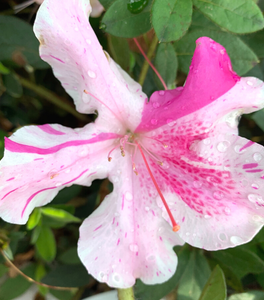Images Depict Mature Plants
Weston's Lemon Drop Azalea Shrubs for Sale Online
Weston's Lemon Drop Azalea shrubs produce an abundance of light yellow flowers with a lemony aroma. They are deciduous Azaleas and the leaves display beautiful fall coloring. Flowers of Weston's Lemon Drop Azalea Shrubs may last up to two weeks or more in the heat of mid-July. The vigorous upright shrub has small blue-green mildew-resistant leaves turning dark pink-red in fall. Winter stems are a distinctive reddish-brown color.
| Hardiness Zone: | 3-8 |
|---|---|
| Mature Height: | 3 to 4 feet |
| Mature Width: | 3 to 4 feet |
| Classification: | Broad leaved deciduous shrub, summer flowering |
| Sunlight: | Full sun to part shade |
| Habit: | Upright, great for naturalizing |
| Foliage: | Bluish-green turning dark red in the fall |
| Flower Color: | Fragrant light yellow |
| Pruning Season: | Prune in late summer after flowering but rarely needed |
| Soil Condition: | Any well drained slightly acidic soil |
| Water Requirements: | Water well until established |
| Uses: | Tolerates moist soil and partial shade or full sun. Full sun brings out the best fall color. Will adapt to drier sites |

How to Care for Weston's Lemon Drop Azalea
Be sure to read our planting instructions to ensure a healthy and happy plant for years to come!
How do I water Weston's Lemon Drop Azalea Shrubs?
After backfilling and lightly compacting the 50/50 mix of existing soil and compost, give the Azalea Weston's Lemon Drop Shrubs a deep watering. Do not rush this process. Most of the water you put on the plant at first will run away from the plant until the soil is soaked. A general rule of thumb is to count to 5 for every one gallon of pot size. For example, when watering a one-gallon pot, do not stop until you count to 5. For a three-gallon container, you would count to 15 before stopping watering. For the first week, check the plant daily and then every other day. Be sure to water using the counting method for the first few weeks.
How do I fertilize Weston's Lemon Drop Azalea Shrubs?
Azalea Weston's Shrubs grow best if fertilized lightly in the spring once frost has passed with a well-balanced, extended-release fertilizer such as Espoma Holly-tone. Fertilize Azalea Lemon Drop again 6 to 8 weeks later to encourage extra flowers or faster growth of young shrubs. Either chemical fertilizers or organic matter can be used successfully with Azalea Weston's Lemon Drop Shrubs. If chemical fertilizers are used on your Azalea Weston's Shrubs, applying a slow-release, balanced fertilizer once a year is probably the simplest solution. However, slow-release is certainly not the only way to fertilizer Azaleas such as Azalea Lemon Drop. A less expensive fast-release fertilizer such as a 10-10-10 will work just as well if applied twice during the early spring and very early summer. Do not fertilize Azalea Weston's Shrubs after August.
How do I mulch Weston's Lemon Drop Azalea Shrubs?
We highly recommend that you mulch your Azalea Weston's Shrubs with either a ground hardwood mulch or a ground cypress mulch depending on your local availability. Any mulch will do, but cypress or hardwood mulch will be of a higher quality. They will also provide better nutrition overall as they break down. Mulching helps keep weeds away that compete with your new investment for water and nutrients. A 2 to 3-inch layer of mulch is sufficient but remember to take care not to cover any part of the stem with mulch. It's better to leave a one-inch gap of space between the mulch and the stem or trunk of the plant.
How Do I Plant My Weston's Lemon Drop Shrub?
We recommend digging a hole twice as wide as the root system but not deeper. Depending on the quality of your existing soil, you may need to add locally sourced compost or topsoil to the back-fill soil. We do not recommend using straight topsoil or compost as a back-fill soil because these products will retain entirely too much moisture and will cause the root system to rot. Adding compost or topsoil will help the young feeder roots of Azaleas spread through the loose, nutrient-rich soil, much easier than if you used only the existing soil that more times than not will be hard and compacted. The most common cause of plant death after transplanting is planting the new plant too deep. That is why we do not recommend planting in a hole deeper than the soil line of the plant in the pot. A good rule is that you should still see the soil the plant was grown in after back-filling the hole.







